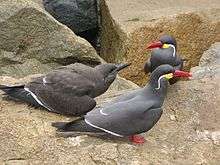Inca tern
| Inca tern | |
|---|---|
_Weltvogelpark_Walsrode_2012-015.jpg) | |
| Inca tern at Walsrode Bird Park, Germany, eating a fish | |
| Scientific classification | |
| Kingdom: | Animalia |
| Phylum: | Chordata |
| Class: | Aves |
| Order: | Charadriiformes |
| Family: | Laridae |
| Genus: | Larosterna Blyth, 1852 |
| Species: | L. inca |
| Binomial name | |
| Larosterna inca (Lesson, 1827) | |
The Inca tern (Larosterna inca) is a tern in the family Laridae. It is the only member of the genus Larosterna.
This uniquely plumaged bird breeds on the coasts of Peru and Chile, and is restricted to the Humboldt Current. It is an erratic, rare visitor to the southwest coast of Ecuador. It can be identified by its dark grey body, white moustache on both sides of its head, and red-orange beak and feet.
Description

The Inca tern is a large tern, approximately 40 cm (16 in) long. Sexes are similar; the adult is mostly slate-grey with white restricted to the facial plumes and the trailing edges of the wings. The large bill and legs are dark red. Immature birds are purple-brown, and gradually develop the facial plumes.
Behaviour
Breeding
The Inca tern breeds on rocky cliffs. It nests in a hollow or burrow or sometimes the old nest of a Humboldt penguin, and lays one or two eggs. The eggs are incubated for about 4 weeks, and the chicks leave the nest after 7 weeks.[2]
Feeding
The Inca tern feeds primarily on small fish, such as anchovies. The species spots its prey from the air, diving into the water to grab meals with its pointed beak.[2] Its call is a cat-like mew.
References
- ↑ BirdLife International (2012). "Larosterna inca". IUCN Red List of Threatened Species. Version 2013.2. International Union for Conservation of Nature. Retrieved 26 November 2013.
- 1 2 "Inca Tern Fact Sheet, Lincoln Park Zoo"
- Harrison, Peter (1988): Seabirds (2nd edition). Christopher Helm, London ISBN 0-7470-1410-8
External links
| Wikimedia Commons has media related to Larosterna inca. |
| Wikispecies has information related to Larosterna inca |
